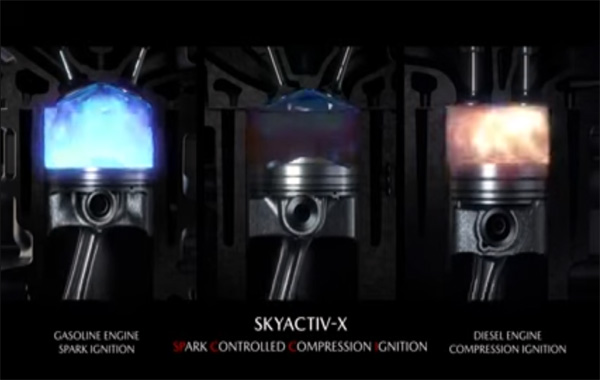What is a Compression-Ignition Petrol Engine?
One of the most recent Compression-Ignition Spark Engines could be Mazda’s SkyActiv-X motor. It was announced for production on the Mazda3 in 2019. Compression-Ignition Petrol Engine merges Petrol and Diesel technologies. And it obtains the benefits of HCCI (homogenous charge compression ignition). Here, the piston’s compression stroke itself ignites & burns the air-fuel mixture.
Diesel engines use HCCI technology. They compress an atomized air-fuel mixture into the combustion chamber to induce ignition. It is quite the opposite of the petrol engines’ spark plug-actuated ignition. Thus, it makes the most of the piston’s full range of motion. In addition, it ignites the mixture at the top of the cylinder’s travel in the chamber. Thus, it makes the engine more fuel-efficient.
Working:
Compression-Ignition Spark Engine builds on this technology by running at a compression ratio of 16:1. Thus, it allows the engine to operate on a leaner fuel ratio than the standard petrol engine. In addition, diesel engines have abolished spark plugs. An intelligent spark plug system called spark-controlled compression ignition (SCCI) enhances the engine’s process. It operates on a “sometimes-on” “sometimes-off” principle.

This system uses a small supercharger to take in an ultra-lean air-fuel mixture. Then, it compresses the mixture to a near-spontaneous explosion point. It occurs just before a second injector adds another fuel charge directly to the spark plug. This ignition raises the pressure in the cylinder. And then the remaining air-fuel mixture catches fire.
Increased Power:
Furthermore, the intelligent combustion management system allows the engine to benefit from HCCI. It does so when conditions are optimal and performs standard ignition when they aren’t. Besides, it also lessens the impact of detonation or knocks. The detonation occurs when the erratic combustion of fuel takes place within the combustion chamber. It is often a consequence of high compression pressures. It could potentially damage the cylinder block, spark plugs, and head gaskets. The effect of this lean-burn technology is a 20-30% enhancement in fuel efficiency and less harmful emissions. Thus, it ensures that this engine retains the top-end power advantage over its diesel counterparts.
Advantages of Compression-Ignition Petrol Engine:
Better Performance: The Compression-Ignition Spark Engine produces more power, with up to 30 percent more torque than the current engines.
Driving Pleasure: Compression-Ignition Spark Engine delivers an instant response when you put your foot down, be it a six-speed manual or six-speed automatic transmission. It pulls pretty similarly to a turbodiesel. However, it spins like a normally aspirated petrol engine.
Fuel Economy: Compression-Ignition Spark Engine improves fuel efficiency up to 20-30 percent over current gasoline engines. Besides, importantly, engineers designed it for real-world efficiency. And not necessarily just to perform well in a testing cycle.
The New Normal: Unlike an EV or other alternative-powered car, there’s no need to ‘relearn’ driving or suffer from range anxiety. Compression-Ignition Spark Engine runs on regular gasoline. Besides, it drives just like you’d expect your car to go.
Future Adaption: Engineers designed the Compression Ignition Spark Engine to work with EVs. You can use it as a standalone power unit or in hybrid and plug-in hybrid arrangements.
Mazda engineers designed & developed a Compression-Ignition Spark Engine. They use it on the Mazda3 2019 version.
Watch a Compression-Ignition Spark Engine or Compression-Ignition Petrol Engine in action here:
Video Courtesy: Mazda
